St. Luke’s team collaborates to make baby's early delivery, surgery successful in rare case
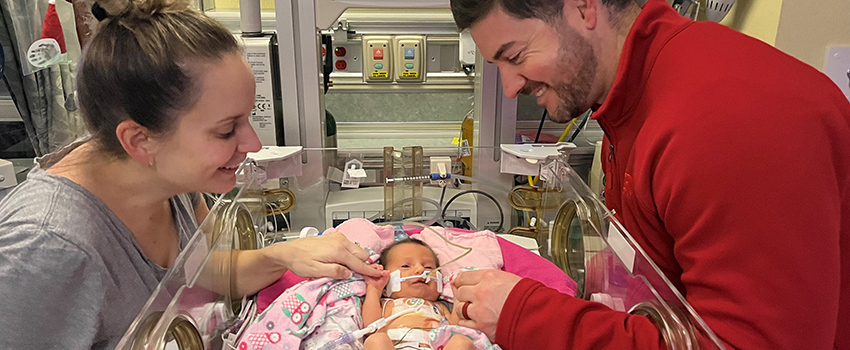
What follows is a story of incredible teamwork, expertise and strength, but it all started with something powerful yet perhaps a little less measurable — a mother’s intuition.
In December 2023, an expecting Natalie Fuller of Meridian noticed her baby, not due for about eight more weeks, wasn’t moving as much as usual.
“I was just getting over having COVID, but it just didn’t feel right since she was normally active,” Fuller said. “I didn’t sleep very well because it was all I could think about.”
The morning of Dec. 21, she talked with her husband, Dustin. He agreed Natalie should reach out to her longtime obstetrician, Dr. Brea Shrum.
Natalie sent a message via MyChart, kicking off a day her family and multiple St. Luke’s teams won’t soon forget. Twelve hours later, it resulted in the birth of daughter Ariya Fuller, but in a way, that was just the beginning.
“I think it very much was a case of everyone playing their part on the team, starting with Natalie,” Dr. Shrum said.
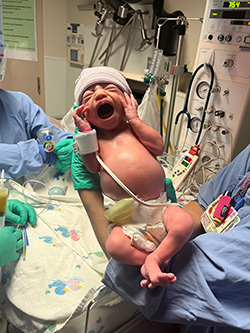
Added maternal fetal medicine specialist Dr. Duncan Harmon: “What happened was no small feat, and the outcome may not have been a good one if they hadn’t contacted us. It’s easy to think, ‘We can just wait,’ so those parents need to be applauded to get this whole thing started.”
Within 10 minutes of sending that message, Natalie had a response from Shrum’s office to come to St. Luke’s Boise for monitoring. The Fullers had their 2-year-old son, Sawyer, at day care, so they had no problem coming in for what they assumed was a regular visit.
“I told my boss I’d be gone only a few hours,” Fuller said with a laugh.
Dustin said the first 30 seconds when the fetal heartrate monitor was being placed were the longest of his life, waiting to see if there was any reason to worry. Shrum said nothing looked immediately abnormal, but the results weren’t ideal — “not concerning, but not reassuring.”
She called Harmon to perform an ultrasound to get a better look.
Harmon fairly quickly noticed Ariya had a dilated bowel. Initially, he thought it may be an atresia, or a blockage. He contacted St. Luke’s Children’s pediatric surgeon Dr. David Klima about what he was seeing. Klima asked if volvulus had been ruled out.
“If it’s atresia, you usually can wait and deliver at term, then address it,” Harmon said. “Volvulus is acute twisting on its own blood supply. That segment dies and it really increases the risk of stillbirth.
“If the diagnosis is wrong, you add risks delivering early when you perhaps did not need to.”
By this time, it was approximately 4:30 p.m., about six hours after that MyChart message was sent.
“When the ultrasound tech, two nurses and Dr. Harmon came in, that’s when the full weight of the situation hit,” Fuller said. “I got lightheaded, put a cold towel on my neck. I heard ‘stillbirth,’ and I knew it wouldn’t be regular checkup.
“But Dr. Shrum tells us how it is, that’s what I like. She said, ‘Drs. Klima and Harmon, they have their jobs for a reason,’ and they’d figure it out. We were ready to do whatever they suggested.”
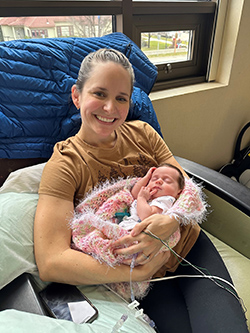
So, Klima and Harmon started researching.
Harmon had a pediatric radiologist look at his images and then reviewed similar cases. Klima called a colleague he had previously worked with for any insight.
At 5:30 p.m., Harmon performed another ultrasound, equipped with a little better idea of what to look for. He noticed a “seashell” shape in the intestine, a certain sign of some twisting.
“I’d never diagnosed a volvulus before, but all the signs pointed that way,” Harmon said.
Added Klima: “Only one other time in my career did I tell (a maternal fetal medicine specialist): ‘You need to deliver now.’”
An emergency C-section was scheduled for 8 p.m., and Shrum delivered newborn Ariya at 8:24 p.m.
“She came out crying, just like you want, but her belly was huge,” Shrum said.
Dustin recalls someone saying, “She looks great from the chest up and the waist down.”
Dr. Klima conferred with Dr. Nathan Thornton, a neonatologist, and Dr. John Waltz, a diagnostic radiologist. Klima noted that Lena Pascual, a nurse practitioner in neonatology, “went above and beyond” by letting Natalie see Ariya for a few minutes before surgery, as a high-risk procedure awaited.
At 10:30 p.m., Klima performed an emergency laparotomy on Ariya.
“The blood vessels that supply and drain the intestine were twisted around each other,” he said. “When I first saw inside, I was afraid of how much bowel might have been dead … but it was only one-third or so that had to be removed.”
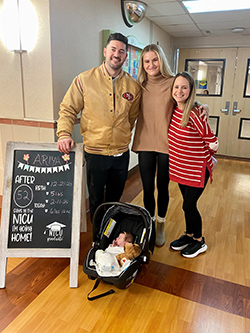
Ariya did well during and following the surgery. Had Natalie and Dustin not been proactive, it is likely their newborn would not have survived if they had waited even a few more days.
“We’ve been told multiple times, for this to work out, it’s unheard of … for each step, Dr. Shrum, Harmon, Klima, someone was watching over us,” Natalie said.
Dustin added: “I think with all of that, I keep appreciating how everyone was like, ‘Let’s check one more thing.’ Everyone went that extra step just to be safe and it turned out that was very much needed.”
Ariya needed a feeding tube and a central venous catheter to help get her proper nutrition. She was in an isolette for a few days before her family could hold her. It was just the start of what wound up being a 52-day stay in the St. Luke’s NICU.
On Feb. 11 — Super Bowl Sunday — Ariya came home.
“I’m a San Francisco 49ers fan, but I was OK after they lost because I had her home — and I had plenty of other things to think about,” Dustin said.
The long-term diagnosis is good for Ariya as she gets stronger. It hasn’t been easy, providing the extra care necessary for a baby who was operated on within hours of being born prematurely.
“I feel everything has exceeded expectations,” Natalie said. “We’ve had to learn a lot of new things and whatever we need to do in the future, we’ll learn and we’ll adapt.”
As happy as her family is, so was the St. Luke’s team.
“If everyone hadn’t talked with each other and communicated, we’d have had a lot different situation,” Shrum said.
Harmon said he intends to send the images he and Klima took during that day to one of his mentors, a pioneer in obstetric imaging, to help other providers who may be in a similar situation.
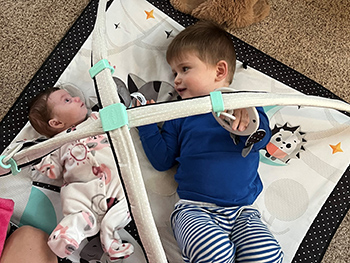
“From (Natalie’s) OB team, labor and delivery, the NICU, surgical staff, pediatric radiology, just think about how many people had to be on their game to make this work,” Harmon said. “These are the types of cases that bolster the sense we are doing good, when you see an outcome like this.
“You never forget the ones that don’t go your way. But you need ones like this when times are tough to go, ‘Look at this. We did this.’”
For Klima, the experience said something about the people at St. Luke’s, committed to carrying out the health system’s focus on safety and mission to improve health.
“It represents who St. Luke’s is, that we’re comfortable having proactive people, like Dr. Shrum calling Dr. Harmon and saying, “Something isn’t quite right,” and him willing to do a repeat ultrasound to feel better about that procedure,” he said. “I don’t know of many health systems where 12 hours after a MyChart message, a baby delivered at 33 weeks and operated on, then has the outcome she did.
“There were so many right decisions made on something that is very rare. I can sit back and say, ‘I was part of something really cool. Look at all the things that happened because of the team we have.’”
About The Author

Dave Southorn works in the Communications and Marketing department at St. Luke's.



